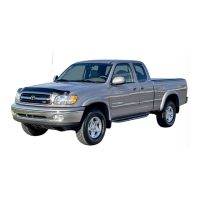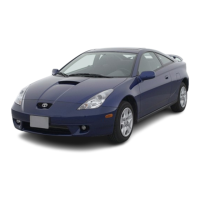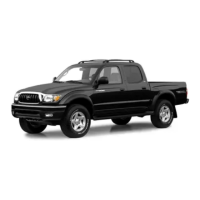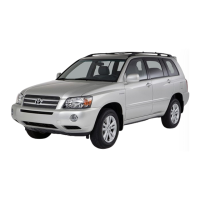Do you have a question about the Toyota 2001 Echo and is the answer not in the manual?
Details on Toyota's limited warranties for your new vehicle.
Outlines owner's duty to ensure scheduled and general maintenance is performed.
Toyota's stance on non-genuine parts and vehicle modifications.
Explains the types of warnings used in the manual and how to interpret them.
Defines the meaning of the universal safety symbol used in the manual.
Introduces the main instrument and control areas of the vehicle.
Detailed diagram and labels for the vehicle's instrument panel components.
Diagram and labels for the main gauges and indicators in the instrument cluster.
Explains various warning and indicator lights found on the instrument panel.
Instructions on using vehicle keys and operating doors, trunk, and hood.
Details on how to lock and unlock side doors using the key or interior buttons.
Operation of the remote system for locking, unlocking, and panic functions.
Procedures for opening and closing the trunk lid and hood.
How to set, activate, and cancel the vehicle's theft deterrent system.
Covers adjustment and use of seating, restraint, and visibility systems.
Details on adjusting front seats and safety precautions, especially with SRS airbags.
Guidelines for proper seat belt use, including pretensioners and adjustments.
Explains the function and precautions for front and side SRS airbags.
Instructions and safety advice for installing child restraint systems.
Operation of exterior and interior lighting, wipers, washer, and defogger.
How to operate headlights, high/low beams, and turn signals.
Instructions for using the windshield wipers and washer system.
How to use the rear window defogger to clear condensation.
Explanation of dashboard gauges, meters, and various warning lights.
How to read the fuel gauge and what the low fuel warning light indicates.
Explains the blue and red indicator lights for engine coolant temperature.
Details on various indicators and buzzers that alert the driver to service needs or system status.
Information on the brake system warning light and ABS warning light.
Explains the SRS warning light and what it indicates about airbag system function.
Covers operation of the ignition, gear selection, and parking brake.
How to use the ignition switch and engage the steering lock.
Detailed instructions for operating the automatic transmission, including shift lock.
Guidance on shifting gears in a manual transmission vehicle.
How to apply and release the parking brake correctly.
Introduction to the vehicle's audio system, controls, and basic operation.
Detailed explanation of buttons, controls, and features for radio, cassette, and CD players.
How to tune, scan, and seek radio stations for optimal reception.
Instructions for using cassette playback, CD playback, track skipping, and random/repeat modes.
How to operate the vehicle's climate control system for heating, cooling, and ventilation.
Details on adjusting fan speed, temperature, air flow, and air intake settings.
Steps to clear fog or frost from windshields and windows using the climate control.
Information on additional interior features like the clock and power outlets.
How to set and reset the digital clock time.
Usage and precautions for the cigarette lighter, ashtray, and power outlet.
Location and use of storage compartments like the glove box and auxiliary boxes.
Information on using cup holders and properly placing floor mats.
Guidelines for the initial driving period to ensure vehicle longevity.
Details on the correct fuel type, octane rating, and additives for your Toyota.
Explains the function and care of the catalytic converter emission control device.
Important safety precautions regarding engine exhaust fumes and system integrity.
Information on the dual-circuit brake system and the function of the brake booster.
How the ABS system works, effective pedal use, and what to expect during activation.
Guidelines for safely stowing luggage and cargo in the vehicle.
Locating the VIN and information on theft prevention labels.
Precautions related to suspension modifications and types of tires.
Pre-start checks to ensure the vehicle is ready for operation.
Step-by-step guide on how to start the engine, including flood conditions.
Advice for safe driving in different weather and road conditions.
Recommendations for preparing and driving your vehicle in cold weather.
Advice on how to improve fuel economy and extend vehicle life through driving habits.
Steps to diagnose and resolve issues when the vehicle fails to start.
Safe procedures for jump starting a vehicle using another battery.
What to do if the engine stalls while driving or overheats.
Step-by-step guide for changing a flat tire, including tool usage.
Guidelines for towing your vehicle safely, including emergency towing options.
How to manually shift the transmission selector lever out of Park.
What to do if you lose your vehicle keys or remote transmitter.
Information on common causes of corrosion and how to prevent it.
Proper procedures for washing, drying, and waxing the vehicle's exterior.
Instructions for cleaning vinyl, carpets, seat belts, and windows.
Explanation of the importance of regular maintenance for vehicle performance and longevity.
Routine checks for tires, fluids, lights, pedals, and interior/exterior components.
How to check engine oil, coolant, brake fluid, power steering fluid, and battery electrolyte.
Clues and signs that indicate your vehicle may require professional attention.
Overview of DIY maintenance, warranty considerations, and safety precautions.
Identification of key components located in the engine compartment.
How to locate and identify fuses in the vehicle's fuse boxes.
Essential safety guidelines and best practices for performing vehicle maintenance.
List of common parts and tools required for performing basic vehicle maintenance.
Instructions on correctly positioning the jack to ensure safety during vehicle lifting.
Guide to essential maintenance tasks for the engine and chassis components.
How to check engine oil level and choose the correct oil type and viscosity.
Procedure for checking coolant level and selecting the appropriate coolant type.
How to check brake fluid and power steering fluid levels.
Guidelines for maintaining correct tire pressure and checking tire tread for wear.
Recommendations for tire rotation, replacement, and wheel selection.
Instructions for installing snow tires and tire chains for winter driving.
Guidelines for replacing vehicle wheels, including selection and installation.
Procedures for maintaining electrical systems like battery and fuses.
How to check battery health and important safety precautions when working with batteries.
Safety guidelines and procedures for recharging a vehicle battery.
Steps for checking blown fuses and replacing them with the correct type.
Instructions on how to access and replace various exterior and interior light bulbs.
Key technical specifications for the vehicle, including dimensions, engine, fuel, and tires.
Physical dimensions and weight ratings of the vehicle.
Details about the engine type, displacement, and fuel requirements.
Technical data for engine lubrication, cooling system, battery, and brakes.
Information on tire sizes, pressures, and fuse ratings.
Procedures for reporting vehicle safety defects to NHTSA and Toyota.
Explanation of DOT quality grades for tires (Treadwear, Traction, Temperature).
| Brand | Toyota |
|---|---|
| Model | 2001 Echo |
| Category | Automobile |
| Language | English |












